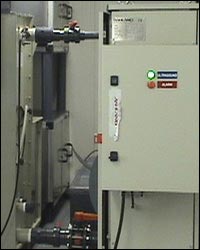Solution to “Legionella”

SONOXIDE system
As a result of the joint working between teams of experts from the Iberia Ashland Chemical, S.A. company and the INASMET-Tecnalia Technological Centre, a solution has been found to prevent the serious disease caused by the bacteria known as “Legionella” and other similar disorders.
This achievement has meant a great advance for human health. It is based on the biocidal and bacteriostatic effect of the SONOXIDE system, used in refrigeration towers of factory buildings and installations that are prone to be the focus for the proliferation of Legionnaires’ disease.
In order to validate the system, the team of INASMET-Tecnalia experts designed a refrigeration tower simulation within a biologically-isolated laboratory (P2 level). A wide range of trials were carried out in this isolated and secure system in order to determine the efficacy thereof.
Regarding the technology developed, it consists of a system based on low-intensity, high-frequency ultrasounds which, together with the introduction of micro-bubbles of air, produce an effect of photo-sonoluminiscence. The concentration of ultrasounds by constructive interference generates a pressure front that produces a decompression of the gases dissolved in the water. This wave front produces a luminous plasma around the bubbles, as well as high pressure and temperatures.
These pressures and temperatures have two effects: on the one hand, they eliminate the circulating bacteria and, on the other, they generate an oxidative stress that is transmitted throughout the water refrigeration system. This stress, together with the continuous loss of circulating bacteria throughout the system, reduces the formation of biofilm even at extremely low levels – and maintains this to such an extent that the fixing of “legionella” bacteria or any other micro-organisms needing biofilm in order to grow in the system, is impeded.
Media Contact
More Information:
http://www.basqueresearch.comAll latest news from the category: Life Sciences and Chemistry
Articles and reports from the Life Sciences and chemistry area deal with applied and basic research into modern biology, chemistry and human medicine.
Valuable information can be found on a range of life sciences fields including bacteriology, biochemistry, bionics, bioinformatics, biophysics, biotechnology, genetics, geobotany, human biology, marine biology, microbiology, molecular biology, cellular biology, zoology, bioinorganic chemistry, microchemistry and environmental chemistry.
Newest articles

Superradiant atoms could push the boundaries of how precisely time can be measured
Superradiant atoms can help us measure time more precisely than ever. In a new study, researchers from the University of Copenhagen present a new method for measuring the time interval,…

Ion thermoelectric conversion devices for near room temperature
The electrode sheet of the thermoelectric device consists of ionic hydrogel, which is sandwiched between the electrodes to form, and the Prussian blue on the electrode undergoes a redox reaction…

Zap Energy achieves 37-million-degree temperatures in a compact device
New publication reports record electron temperatures for a small-scale, sheared-flow-stabilized Z-pinch fusion device. In the nine decades since humans first produced fusion reactions, only a few fusion technologies have demonstrated…





















